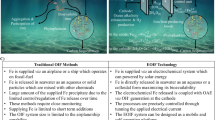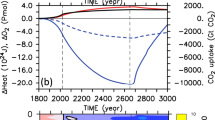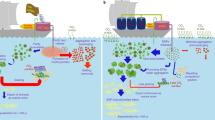Abstract
To alleviate the increasing atmospheric concentrations of carbon dioxide, the principal greenhouse gas, Marchetti1 proposed that CO2, might be separated from flue gases and injected into the oceans. This, and subsequent studies2–5, emphasized the need to inject the gas at great depths or in sinking currents to avoid rapid outgassing to the atmosphere. Here we show that, to the contrary, the increase in water density that results from CO2, dissolution may be sufficient to transport the dissolved gas to lower depths even for shallow injection (in the upper 200–400 m of the ocean). If the CO2 is injected near the shore, gravity currents will carry the dense, CO2-rich waters along the bottom slope towards deep water. Shallow injection near the shore will be less expensive in terms of energy and capital than deep-ocean injection. We suggest that the coast of Norway, in the vicinity of existing oil and gas fields and of planned gas power plants, provides an example of a region where the negative buoyancy of CO2-enriched sea water would transport the gas from emission sites to the deep ocean. The effect of such measures on marine life downstream of the injection point remains to be evaluated.
This is a preview of subscription content, access via your institution
Access options
Subscribe to this journal
Receive 51 print issues and online access
$199.00 per year
only $3.90 per issue
Buy this article
- Purchase on Springer Link
- Instant access to full article PDF
Prices may be subject to local taxes which are calculated during checkout
Similar content being viewed by others
References
Marchetti, C. Clim. Change 1, 59–68 (1977).
Baes, C. F. Jr et al. in Interactions of Energy and Climate (eds Bach, W., Pankrath, J. & Williams, J.) 495–519 (Reidel, Dordrecht, 1980).
Herzog, H., Golomb, D. & Zemba, S. Env. Prog. 10, 64–74 (1991).
Bacastow, R. & Stegen, G. R. in Proc. Oceans '91 Vol. 3, 1654–1657 (IEEE. Honolulu, Hawaii, 1991).
Stegen, G. R., Cole, K. H. & Bacastow, R. in Proc. IEA Int. Conf. Technology Responses to Global Environmental Challenges (IEA, Kyoto, Japan, 1991).
Maier-Reimer, E. in Strategies for Future Climate Research (ed. M. Latif) 319–339 (Max-Planck-Institut für Meteorologie, Hamburg, 1991).
Watanabe, H. & Iizuka, K. Metrologia 21, 19–26 (1985).
King, M. B. Phase Equilibrium in Mixtures (Pergamon, Oxford, 1969).
UNESCO Technical Papers in Marine Science 36 (UNESCO, Paris, 1981).
Smith, P. C. Deep Sea Res. 22, 853–873 (1975).
Chu, P. C. & Gascard, J.-C. (ed.) Deep Convection and Deep Water Formation in the Oceans (Elsevier, Amsterdam, 1991).
Clift, R., Grace, J. R. & Weber, M. E. Bubbles, Drops and Particles (Academic, New York, 1978).
Tse, F. C. & Sandall, O. C. Chem. Engng. Commun. 3, 147–153 (1979).
Calderbank, P. H., Johnson, D. S. L. & Loudon, J. Chem. Engng. Sci. 25, 235–256 (1970).
Grace, J. R., Wairegi, T. & Brophy, J. Can. J. Chem. Engng. 56, 3–8 (1978).
Killworth, P. D. Deep Sea Res. 24, 427–448 (1977).
Turner, J. S. Buoyancy Effects in Fluids (Cambridge Univ. Press, 1973).
Turner, J. S. in The Evolution of Physical Oceanography (ed. Warren, B. A. & Wunsch, C.) 236–262 (MIT Press, Cambridge, Massachusetts, 1981).
Stumm, W. & Morgan, J. J. Aquatic Chemistry 2nd edn (Wiley, New York, 1981).
Otto, L. et al. Neth. J. Sea Res. 26, 161–238 (1990).
Bishnoi, P. R. & Robinson, D. B. Can. J. Chem. Engng. 49, 642–650 (1971).
Cheney, W. & Kincaid, D. Numerical Mathematics and Computing (Brooks/Cole, Monterey, California, 1985).
UNESCO Technical Papers in Marine Science 51 (UNESCO, Paris, 1987).
Weiss, R. F. Mar. Chem. 2, 203–215 (1974).
Levine, I. N. Physical Chemistry (McGraw-Hill, New York, 1988).
CRC Handbook of Chemistry and Physics 68th Edn (ed. Weast, R. C.) (CRC Press, Boca Raton, Florida, 1987).
Sakai, H. et al. Science 248, 1093–1096 (1990).
Author information
Authors and Affiliations
Rights and permissions
About this article
Cite this article
Haugan, P., Drange, H. Sequestration of C02 in the deep ocean by shallow injection. Nature 357, 318–320 (1992). https://doi.org/10.1038/357318a0
Received:
Accepted:
Issue Date:
DOI: https://doi.org/10.1038/357318a0
This article is cited by
-
How Properties of Solid Surfaces Modulate the Nucleation of Gas Hydrate
Scientific Reports (2015)
-
Density measurement and equal density temperature of CO2+brine from Dagang — formation from 313 to 363 K
Korean Journal of Chemical Engineering (2015)
-
Dissociation behavior of (CH4 + C2H4) hydrate in the presence of sodium dodecyl sulfate
Petroleum Science (2010)
-
Simulating CO2 transport into the ocean from a CO2 lake at the seafloor using a z- and a σ-coordinate model
Ocean Dynamics (2009)
-
Lethality of increasing CO2 levels on deep-sea copepods in the western North Pacific
Journal of Oceanography (2006)
Comments
By submitting a comment you agree to abide by our Terms and Community Guidelines. If you find something abusive or that does not comply with our terms or guidelines please flag it as inappropriate.



